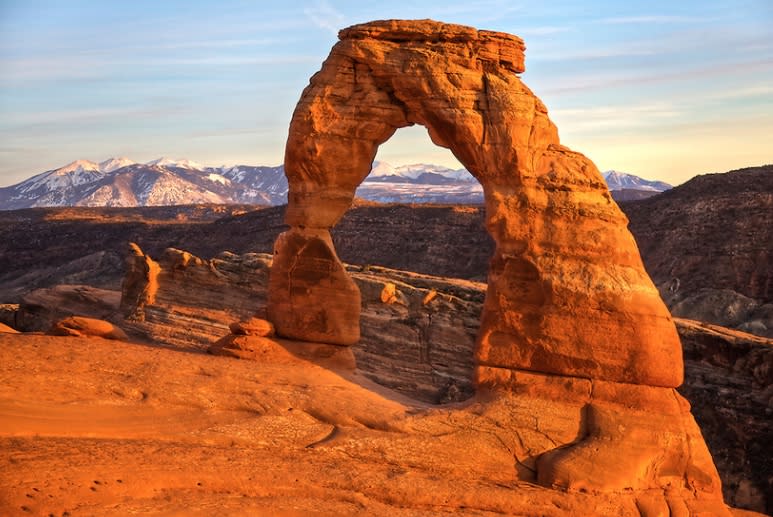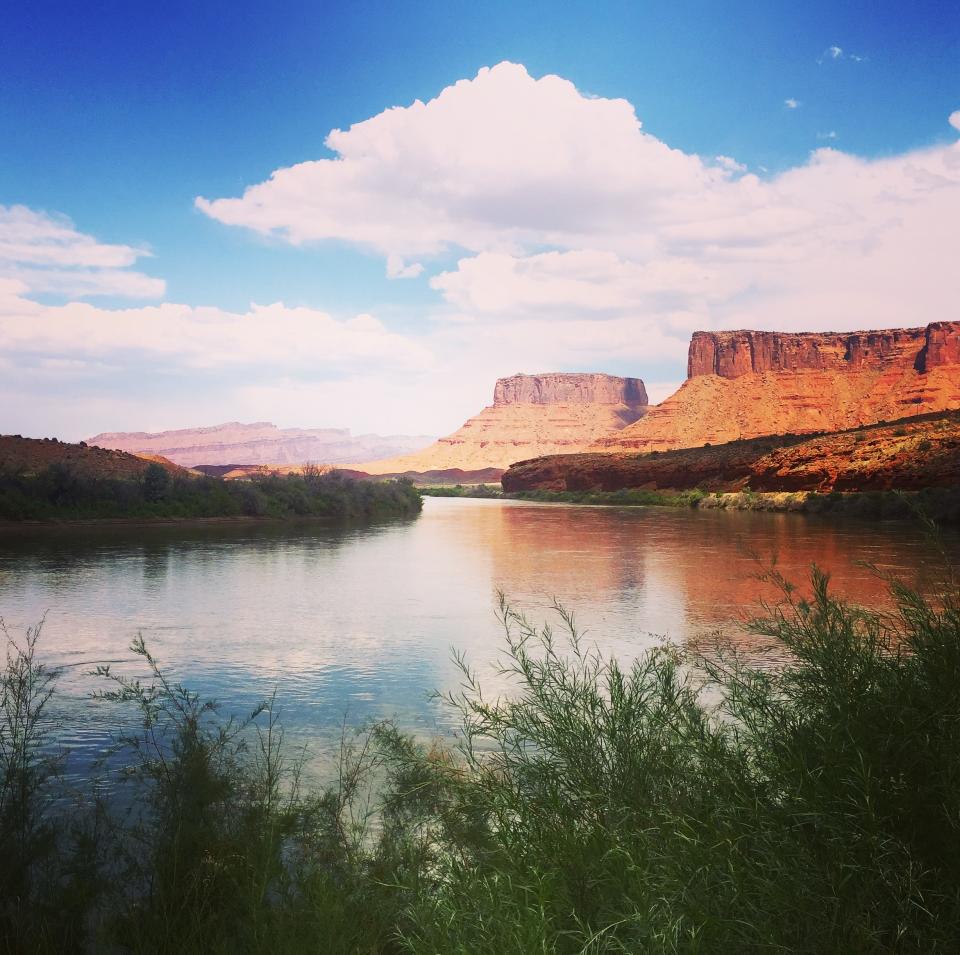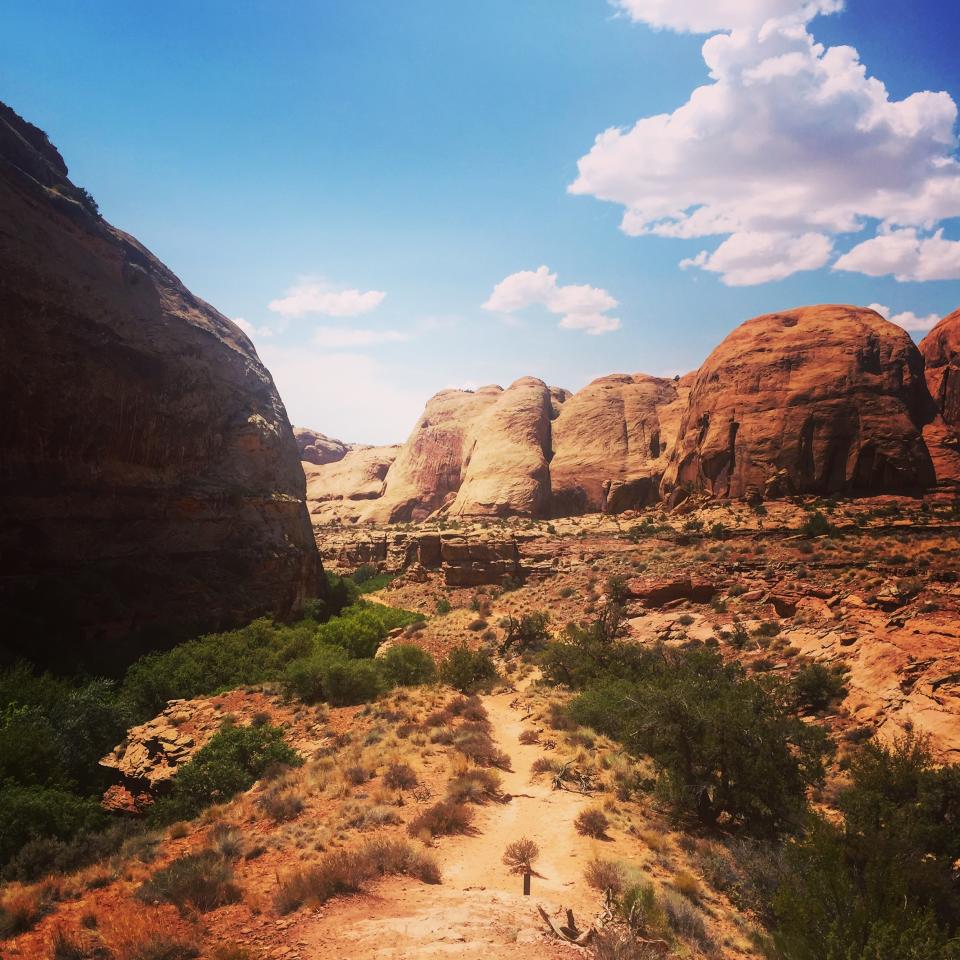Moab: Utah's magical town in the sun

We were warned not to go to in the summer when the temperatures in Moab hover in the three-digits by mid-morning, and where neighboring forest fires, stoked by the heat, can haze the skies and keep planes on the ground. Yet, how unpleasant could it be? As long as you’re not a dog left baking in the back seat—God knows there would be lots of warnings against that—and you didn’t wander off without water, couldn’t southern Utah still be an astonishing place to visit?
The answer is yes, definitely yes.
That isn’t to say that fear and common sense don’t have their role — especially when local forecasts swap out terms like “sunny” or “hot” for “melting” — only that sometimes you need to take a risk and embrace the reward, even if there’s a lot of sizzle that surrounds it.
There’s certainly plenty of sizzle here. It’s why Moab has such outsized fame and popularity for a town of 5,000 in the middle of nowhere. (The closest major airport, for instance, is in Salt Lake City, more than four-hours’ drive north). It’s a legendary spot for mountain-bikers and hikers, yet it’s only once you arrive that you realize why it’s so beloved by their sort, and more importantly, why you don’t necessarily need to do either to adore the place.

2,000 curves to the Devil’s campsite
One thing you must do is see Arches National Park. Indeed, Arches is so intrinsic to the magnificence of Moab that not visiting it would be like going to the Grand Canyon and not looking over the edge.
The canyon is actually a good analogy because Arches is less a singular spot, than a sprawling 77,000-acre oasis of sandstone and perilously perched rocks. There’s more than 2,000 of them, soaring bridge-like overhead. Some gigantic spans serve as the main crowd-pleasers though most are fairly modest. Yet they’re everywhere. It’s what makes the park so spectacular. Rather than two or three vistas where everyone pulls over, piles out and takes photos, there are seemingly endless places to stop and gaze or simply soak it up as you drive through.
The main entrance to the park is eight kilometres north of town, and is open 24 hours a day, year-round. These details are worth noting only because the park can look and feel so vastly different depending on when you visit. Even though we were only in Moab for a few days, we went multiple times — at dawn, in the afternoon, at night — and saw dramatically different scenes each time. The most stunning moments are said to be under a full moon, though the view our night was slightly dulled by the haze of the nearby fires. Next time we’ll book well in advance for one of the 50 spots at the Devil’s Garden campground near the north end of the park.

If you only have an occasion to go once, and you’re up for a bit of a walk, there’s no better option than the Park Avenue trail, a three-kilometre hike, near the main entrance, that zig-zags along the bottom of a mini canyon and that features some absolutely breathtaking rock formations. We went early in the morning, ensuring that the path was not only shaded but largely deserted for almost the entire way, in both directions. No matter when you go, it is well worth the trek.

El San Ignacio quesadilla por favor
Once you’ve toured Arches, whether on foot or by car, your next stop should be back to Moab to fill up. This is especially true in the summer, when the sun stops being your friend after a few hours. Unfortunately, it’s almost impossible to be fair to the restaurant scene in town because very good dining options here are like great hikes, or stunning-looking rocks, in the park. Even narrowing it down to a top five is tough.
Nevertheless, if pressed for one, I would go with Miguel’s Baja Grill on the main strip. It’s the place the front desk clerk at our hotel extolled, though not before explaining in detail the myriad differences between Tex and Mex, and he being Mexican, said he could think of no better choice than Miguel’s.
This would prove to be a very popular, if initially mysterious, pick, for when we headed over for a late lunch we found the lights off and the door locked. It turns out that Miguel’s is only open for dinner. More specifically, from 5 pm to 10 pm.
While it may be shut most of the time, when it’s open, it’s packed, mostly with families seeking the traditional assortment of tacos, burritos, quesadillas and fajitas, all in massive quantities at very modest prices. An avant garde or fusion eatery it is not. Mexican cuisine isn’t being re-imagined here as much as being served up, at volume, to people prepared to suffer long line ups. At least judging by the scene on the sidewalk when we left.
(Not being a foodie, I won’t try to describe our dinner, except to say that I ordered the San Ignacio quesadilla [US$11.99] because it sounded extra authentic, and kind of exotic. I assumed it was named for a beloved patron saint from Mexico, maybe from the owner’s ancestral village. Actually, no, nothing so fabled. San Ignacio is just a small town in Belize.)

The Grand Canyon stand-in
On the subject of places… as this story is ostensibly about Moab, I should probably linger a bit here, describe the buildings, the little creek that cuts beneath Main Street, the outdoorsy stores, the vibe on the sidewalks. But alas, that would be a mistake, for as pleasant a place as Moab is, its claims to fame are definitely not downtown. That’s just where you eat and sleep. The really spectacular sights are outside the city limits.
If Arches is the first stop, the second has to be Dead Horse Point State Park, a setting that needs to be seen to be believed, and even then, it’s scarcely conceivable. And the most astonishing thing is the reveal. That only comes after climbing a gradually ascending series of plateaus, stretched over the 50-km drive from Moab. The sensation is akin to a prairie gently rising, so that even after you’ve arrived and stepped out of the car there are almost no hints of the dramatic drop that awaits just a few feet ahead.
And dramatic is the right word. In the final moments of “Thelma & Louise,” when the lead characters decide to end it all by driving their Thunderbird over a cliff, it’s here where they hit the gas. (In the movie, this is supposed to be at the Grand Canyon, which speaks to how impressively park resembles its vastly bigger counterpart 500-km away.)
Just like in the Grand Canyon, it’s the Colorado River that winds its way through the valley 600 metres below. However, here there are no paths to the water from atop the plateau. Or at least, they’re not referenced in any of park’s signs or maps. Instead the focus is very much on the minimalist campsites and the hiking and cycling trails that crisscross the plateau, skirting spectacularly close to the edge.
Again, although our time was limited, we made an effort to visit the park twice. First in the evening to see the sunset as we walked along the rim, and then again early the next morning to mountain bike through some of Dead Horse Point’s incredible 160-km-plus trail system.

Pork, beans and cowboy tales
To actually reach to the Colorado River — safely, that is — you need to reverse course and return almost to Moab, where the river rolls slowly by, just outside of town.
In the summer, the water is a welcome respite, attracting kayakers, paddle-boarders and rafters. While beloved, it’s also underestimated, especially the undertow. A manager of a popular lodge along the banks told us that a common sight, when standing on their terrace, was to see an empty kayak or inner tube float lazily past, its former occupant somewhere upstream, standing thigh-high in shallow waters, wondering about their damage deposit.
The other extremely popular river activity is the Canyonlands Dinner and Light show, which begins with a “cowboy-style” dinner — meaning BBQ beef, pork, chicken and plenty of beans — and then proceeds to an open-air boat cruise down the Colorado. As the sun sets and the river is cloaked in darkness, the canyon walls are illuminated by 40,000 watts of light, projected from a truck keeping pace with the cruise on a parallel road. What unfolds along the rocks is the story of how the canyons were created, and the area first settled.
The cowboy theme of the evening re-surfaces loud and cringingly clear at this point. The rough-hewn heroes of this narrative were the early Spanish missionaries and then later, en masse, the Mormon faithful, who overcame the ‘savages’ and created the Utah that exists today. To a Canadian accustomed to much subtler forms of racism when it comes to Indigenous people, hearing such a nakedly jaundiced tale of how the west was won was both shocking and illuminating. The cruise could be accused of many things, though political correctness is not among them.

The great Grandstaff
Clearly it was time for a long walk in the wilderness. And here we come to perhaps the highlight of the trip. It’s placed near the end here not due to any nonchalance, but only because interest in a 6.5-km hike in the scorching heat may be limited. That said, if you like hiking and have a big water bottle, trekking the Grandstaff Trail is an absolutely spectacular way to spend an afternoon.
The path starts next to the Colorado River, roughly seven kilometres north of town, and cuts immediately into the canyons, following the path of a tiny stream. Along the way you’ll pass through dense stands of cottonwoods and willows, that providing momentary shade from the sun. (We were led to believe the whole trail unfurled in the shade. Actually no, not even close.) Still, the stream constantly by our side proved a wonderful salvation, allowing us to dip in and cool off every 20 minutes or so.
In addition to being a gorgeous spot to hike, the trail is famed for two things: the Morning Glory Natural Bridge, one of the largest rock spans in the country, which soars overhead just before you reach the end, and then the turnaround point itself, a spectacular sandstone grotto, with water trickling down its sides, and a smooth, shaded base to simply sit and soak in the beauty.
Getting there
There is a small airfield in Moab that sees direct flights from Salt Lake City, Denver and Las Vegas, but as there are relatively few car rental places in town, and you do need a car in Moab, flying into Salt Lake City then driving south, is the more common move. As noted above, it’s a four-hour drive crossing diagonally through the heart of Utah, past the Wasatch mountain range, through prairie lands and into the sandstone desert. The entire route is extremely scenic and very easy driving.
Apparently even more stunning, though much further at nearly seven hours, is the drive northeast from Las Vegas to Moab. That approach takes you past Zion National Park and through a number of national forest sites across the southern half of Utah. Traveling west from Denver is also an option and is comparable to the Vegas drive.
There are daily direct flights from Toronto to all three cities.
Where to stay
The hotels in Moab clearly know their clientele. It’s hikers, cyclists, sightseers and families coming for the week. The accommodation reflects that, with lots of choice in the three-star range (i.e. La Quinta, Best Western, Holiday Inn, Homewood Suites) though much fewer in the backpacker category or at the five-star level. And in fairness, no one comes to Moab to see the inside of a hotel room.
We stayed at La Quinta which was walking distance to all of the shops and restaurants downtown. It was clean, quiet, cheap and cheerful. However there are countless other options, with most either on or very close to the main strip. Judging from the prices and guest reviews online, it’s probably fair to say they’re all equally appealing.

Download the Yahoo Finance app, available for Apple and Android.

 Yahoo Finance
Yahoo Finance 
